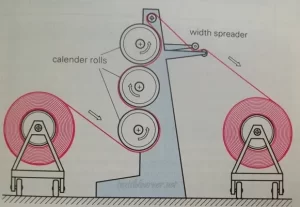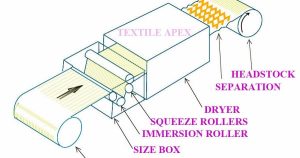LESSON-2:VARIOUS TERMS USED IN FINISHING OF FABRIC
VARIOUS TERM USED IN TEXTILE FINISHING
FINISHING: – A finish is anything is done to a fiber, yarn or a fabric to improve the appearance.
A finish lessons the roughness of a fabric and makes it look beautiful, smooth and attractive. It is a finish that determines the degree of satisfaction and dissatisfaction that the consumer experience with a specific fabric.
Newly constructed fabrics when they come out from the mill are called GREY GOODS. Finishing process are under taken by highly specialize companies called converters.
Finishing is a final process given to a textile material to:-
- Give a good appearance
- Desirable feel
- Impart certain durable properties like Stiffness, Softness, Wash and Wear finish, Water repelling finish, Fire proof finish.

- Chemical finishing
The finishes applied by means of chemicals of different origins, a fabric can receive properties otherwise impossible to obtain with mechanical means. Commonly used chemical finishes include softening, stiffening / hand-building, easy-care / wrinkle-recovery / durable-press, water / oil repellent, soil repellent, soil release, flame retardant, anti-slip, anti-static, anti-pilling, anti-microbial, elastomeric, UV protection, insect resistant / moth protection, bio-polishing, fragrance, moisture management, temperature adaptability, and finishes to improve colour fastness of the dyed or printed fabrics. Some requirements of chemical finishes include:- Desired durability of the finishing effect
- No loss of desirable fabric properties, e. g. appearance, hand-feel, strength,
comfort, abrasion resistance - No yellowing of the white finished fabric
- No change in color of the dyed or printed fabric
- Safe to use and simple to apply on the fabric
- Good storage stability and shelf life
- Good compatibility with other ingredients of the finishing formulation
- Easy correction in case of faulty finish application
- Sustainability and no harmful impact on the environment
Flame Retardant:- Flame retardants are chemicals that are applied to materials to prevent the start or slow the growth of fire. They have been used in many consumer and industrial products. Are applied to combustible fabrics used in children’s sleepwear, carpets and curtains and prevent highly flammable textiles from bursting into flame.
Flame retardants are often added or applied to the following products.
- Furnishings, such as foam, upholstery, mattresses, carpets, curtains, and fabric blinds.
- Electronics and electrical devices, such as computers, laptops, phones, televisions, and household appliances, plus wires and cables.
- Building and construction materials, including electrical wires and cables, and insulation materials, such as polystyrene and polyurethane insulation foams.
- Transportation products, such as seats, seat covers and fillings, bumpers,
- Overhead compartments, and other parts of automobiles, airplanes, and trains.
Antistatic finish: – It is a chemical finish. Static charges that develop on the fabric cause them cling to machinery in the factory and to people. It will also attached dust, lint & produce sparks and shocks, control of static build upon natural fibers is done by increasing the humanity and by using lubricants like oily, Greece. But these controls do not always work. Antistatic finishes were developed
1) To improve the surface of conductivity so that the extra electrons move to the atmosphere.
2) Attract water molecules- thus increasing the conductivity of the fibers
3) Develop a charge opposite that of the fibre thus neutralising the electrostatic charge.
Most antistatic finishes are not durable and must be replaced during care. Most finishes use fabric softness to control static electricity. Some of the fabrics which have static charges are rugs, carpets.
SOFTENER FINISH:-Softener is an auxiliary that, when applied to textile materials, brings about an alteration in the handle, resulting in the goods being more pleasing to the touch. Softening finishes are among the most important of textile chemical after treatments. Softening is carried out when the softness characteristics of a certain fabric must be improved, always carefully considering the composition and properties of the substrate.
WATER RESISTANT:- The term “water resistance” describes a degree by which water droplets are able to wet and penetrate a fabric. Some people use the terms water-resistant and water-repellent interchangeably, while others argue that water-resistant and waterproof are the same. Actually, rain-resistant fabrics also known as water-resistant are in-between water-repellent and waterproof textiles. Water-resistant fabrics and clothes are supposed to keep you dry in moderate to heavy rain. So they provide better protection against rain and snow than water-repellent textiles. However, in prolonged wet weather, garments made of water-resistant textiles cannot protect you for too long as they will eventually allow water to leak through. In bad weather, this makes them less reliable than waterproof breathable clothes and gear (which are resistant to higher hydrostatic pressure). Rain-resistant clothes are often made from tightly woven man-made fabrics such as polyester and nylon. Other densely woven fabrics such as taffeta and even cotton are also readily used for manufacturing water-resistant clothing and gear.
ANTISTATIC FINISH:- is used for the removal in synthetic fibers of the unwanted effects of electrostatic charge produced during production and wear of fabrics and knits. Electrostatic charge causes an undesirable adhesive power and a resultant shabbiness. It is applied by means of an anti-static chemical treatment, the effect of which may be temporary or permanent.
Crease resistant or Crease proofing:-
Crease Resistant Finishes are applied to cellulose fibers (cotton, linen and rayon) that wrinkle easily. Permanent Press fabrics have crease resistant finishes that resist wrinkling and also help to maintain creases and pleats throughout wearing and cleaning.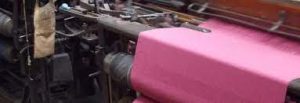
Anti-Pilling
Pilling is a phenomenon exhibited by fabrics formed from spun yarns (yarns made from staple fibers). Pills are masses of tangled fibers that appear on fabric surfaces during wear or laundering. Fabrics with pills have an unsightly appearance and an unpleasant handle. Loose fibers are pulled from yarns and are formed into spherical balls by the frictional forces of abrasion. These balls of tangled fibers are held to the fabric surface by longer fibers called anchor fibers.Anti-pilling finish reduces the forming of pills on fabrics and knitted products made from yarns with synthetic-fibre content, which are inclined to pilling by their considerable strength, flexibility and resistance to impact. Anti-pilling finish is based on the use of chemical treatments which aim to suppress the ability of fibers to slacken and also to reduce the mechanical resistance of synthetic fibre.

Stain and Soil resistant finishes
Prevent soil and stains from being attracted to fabrics. Such finishes may be resistant to oil-bourse or water-Bourne soil and stains or both. Stain and soil resistant finishes can be applied to fabrics used in clothing and furniture. Scotchgard is a stain and soil resistant finish commonly applied to carpet and furniture.Oil and Water proofing
Waterproof Finishes -Allows no water to penetrate, but tend to be uncomfortable because they trap moisture next to the body. Recently, fabrics have been developed that are waterproof, yet are also breathableWater-repellent finishes
Water-repellent finishes resist wetting. If the fabric becomes very wet, water will eventually pass through. Applied to fabrics found in raincoats, all-weather coats, hats, capes, umbrellas and shower curtains.Anti mildew
In certain ambient (humidity and heat) conditions, cellulose can be permanently damaged. This damage can be due to depolymerisation of the cellulose or to the fact that certain microorganisms (mildews) feed off it. The situation is worsened, during long storage periods, by the presence of starch finishing agents. This damage can be prevented by the use of antiseptics, bacteria controlling products containing quaternary ammonium salts, and phenol derivatives. Dyestuffs containing heavy metals can also act as antiseptics. Permanent modification of the fiber (cyanoethylation) is another possibility.Mothproofing finishes
Protect protein-containing fibers, such as wool, from being attacked by moths, carpet beetles and other insects.Antibacterial finish
The inherent properties of textile fibers provide room for the growth of micro-organisms. The structure and chemical process may induce the growth, but it is the humid and warm environment that aggravates the problem further. Antimicrobial finish is applied to textile materials with a view to protect the wearer and textile substrate itself.Antimicrobial finish provides the various benefits of controlling the infestation (hurdle) by microbes protect textiles from staining, discoloration, and quality deterioration and prevents the odour (smell) formation. Anti-microbial agents can be applied to the textile substrates by exhaust, pad-dry-cure, coating, spray and foam techniques. The application of the finish is now extended to textiles used for outdoor, healthcare sector, sports and leisure.
UV Protection Fabric treated with UV absorbers ensures that the clothes deflect the harmful ultraviolet rays of the sun, reducing a person’s UVR exposure and protecting the skin from potential damage. The extent of skin protection required by different types of human skin depends on UV radiation intensity and distribution with reference to geographical location, time of day, and season. This protection is expressed as SPF (Sun Protection Factor), higher the SPF value better is the protection against UV radiation.- Mechanical Finishing:
Involving the application of physical principles such as friction, temperature, pressure, tension and many others. Commonly used mechanical finishes include calendaring, compressive shrinkage / Sanforizing, raising, emerizing / sueding / peaching, shearing / cropping.
Calendaring
A process of passing cloth between rollers (or “calendars”), usually under carefully controlled heat and pressure, to produce a variety of surface textures or effects in fabric such as compact, smooth, supple, flat and glazed. The process involves passing fabric through a calendar in which a highly polished, usually heated, steel bowl rotates at a higher surface speed than the softer (e.g. cotton or paper packed) bowl against which it works, thus producing a glaze on the face of the fabric that is in contact with the steel bowl. The normal woven fabric surface is not flat, particularly in ordinary quality plain weave fabrics, because of the round shape of the yarns, and interlacing of warp and weft at right angles to each other. In such fabrics it is more often seen that even when the fabric is quite regular, it is not flat.The calender machines may have several rollers, some of which can be heated and varied in speed, so that in addition to pressure a polishing action can be exerted to increase luster.
There are several types of calenders like:-
- GLAZED CALENDER
- CIRED CALENDER
- MOIRE CALENDER
- SCHREINER CALENDER
- EMBOSSED CALENDER
- GLAZED CALENDER:- In this type of finishing a fabric is first treated with starches , waxes and then applied suitable chemical. It is then bright and calendered. The speed of rollers are greater than the ordinary rollers.
- CIRED CALANDER: – A cired finished is similar to glazed finish but in this case a metal rollers are hot (heated). As result the fabrics surface is more shinny.
- MOIER CALANDERING: – Certain fabrics have a wood grain or water marked appearance, which is produced by moiering in this method and embossed metal roller is used. This roller has the design engraphed on it. As the result the fabric gets the same impression.
- SCHREINERISING: – In this finish fabric have a softer lusture. In this metal engraphed roller with 200,300 fine diagonal lines are used. This finish gives a deep seated lustre. It flattens the yarns them more cover for light reflection. This type of finish is mainly done for sateen and tee mark cloth.
SINGEING: – It is a mechanical finish. If a fabric is to have a smooth finish then singeing is one of the first important process. Almost all types of cotton fabrics are singed. Wool & silk are very rarely singed. As the fibre ends cling to themselves and manmade fibers melt very easily so they are also not singed. Singeing refers to burn the surface or something slightly, usually by accident, to be burnt in this way. The main purpose of singeing is to burn the protruding fibers from the yarn or fabric surface. It is also called GASSING. Singeing is a process applied to both yarns and fabrics to produce an even surface by burning off projecting fibers, yarn ends and fuzz.
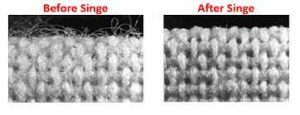
HEAT SETTING: – It is a mechanical finish. The fabric is usually placed on a tender flame and passed through at oven there. The time is exposure and temperature is carefully controlled depending upon the fibre content & suitable chemicals. Suitable chemicals are added to the fabric. Heat setting needs to be carefully monitored. Heat setting of synthetic can also be done to improve their twist, crimp & wrinkle resistance. It is also used during shrinkage control process.

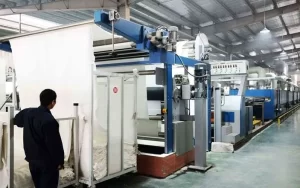
BEETLING: – It is a mechanical finish apply to cotton, linen fabrics. It increases the shine-lustre of the fabric by flattening the yarns to provide more area for light reflection. In this process the fabric is fad over rollers that rotates in a machine where large hammers rise & fall on the surface of the fabric. Continued action flattens the yarn. This type of finish should be carefully monitored. Fabrics used for table covering are generally given this finish to at lustre.
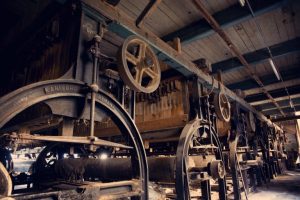
BRUSHING AND SHEARING: – It is a mechanical finish. This finish is given to remove all small fibers sticking on the surface of the cloth. In this, material passes through two rollers brushes and the material from both the sides is cleaned.
Shearing is done to smoothen the surface as well as even the pile. For giving a carved effect, designs and ground can be cut in different lengths. The shearing device has revolving blades similar to lawn roller.
After shearing the fabric is automatically finished in order to remove the sheared ends of the yarns. These finishes are applied to any type of fabric.
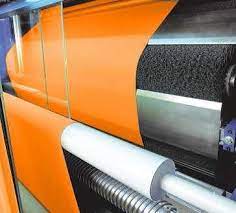
Embossing
This particular type of calendaring process allows engraving a simple pattern on the fabric. To produce a pattern in relief by passing fabric through a calendar in which a heated metal bowl engraved with the pattern works against a relatively soft bowl, built up of compressed paper or cotton on a metal centre.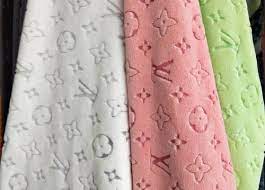

Raising or Napping
Napping is chiefly used to obtain relatively deep surface, but the degree of depth depends upon the techniques used. When the fabric is to be napped, the yarns intended for the construction of the cloth are giving only a slack twist in the spinning process. The fabric is passed under a roller that has fine steel wires with small hooks on the ends. The hooks scrape the surface of the fabric, pulling up the fibre ends out of yarn.A fuzzy finish, produced by napping makes a soft fabric, which provide warmth because of the insulative air cells in the nap. The thicker the nap the more air cells and warmer the fabric. The stains can be removed more rapidly from a napped surface. Napping may also serve to cover up a sleazy construction and weaving imperfections. Wool flannel is the example of napped fabrics. Cotton and spun rayon fabrics are napped when soft, fuzzy surface is desired.
Sanforising or Pre Shrinking
All the textile fibers are made up of fine threads. These threads during weaving and knitting process are strained or stretched to great extent. Therefore freshly made fabrics are not perfectly stable in size and are generally larger than these would be if the strains were relieved. Due to above reasons all fabrics loss their normal shape after washing due to shrinkage of threads. This problem is further enhanced during finishing where the cloth is passed through calendaring or other machines, thus further stretching the fabric.

